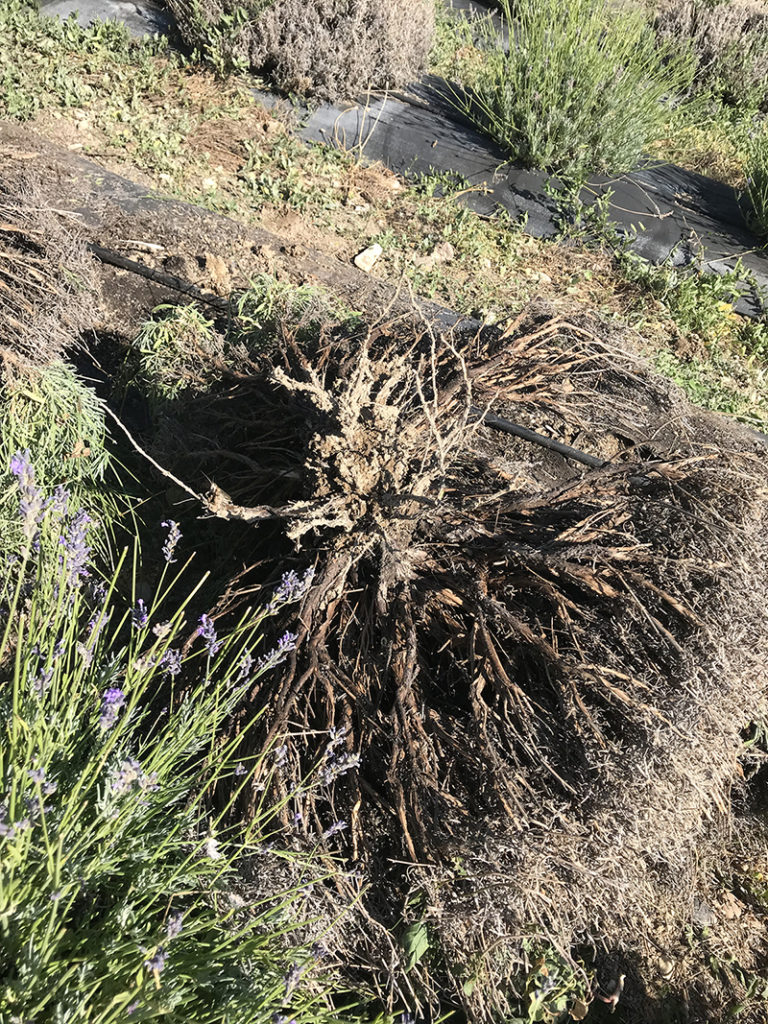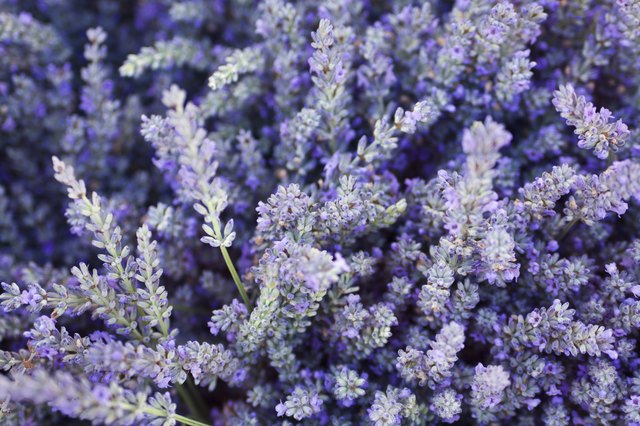Lavender’s a hardy plant, but it’s not invincible. If you grow a lot of lavender, you will lose plants every year, either when they are dormant in the winter or when they are growing. We lost lavender plants this summer, as many have.
This isn’t only true for large-scale growers, though. Even home gardeners can experience losing a lavender plant.
How do you know if a lavender plant is dead? When is the best time to re-plant lavender? That’s what this post is about.
Lavender is a hardy perennial shrub that thrives for many years with proper growing conditions. Its gray-green foliage, vibrant flowers, and appealing scent make it a favorite for gardens But in cold winter climates, lavender can look dead and drab during its winter dormancy Does this mean it is dying?
Understanding lavender’s seasonal growth cycle helps take the guesswork out of winter dieback. With the right care, lavender will return healthy and vigorous every spring.
Lavender Growth by Season
Lavender goes through distinct seasonal phases in its growth and appearance Here is what to expect as the seasons change
Spring
- Dormant plants begin sending up green shoots and foliage as soil warms.
- Flower stalks elongate and fat, green bud bundles form at the tips.
- First blooms appear, typically starting in early summer. Bloom time depends on variety.
- Plants grow bushy and full through summer.
Summer
- Peak flowering occurs, with long lasting blooms.
- Plants reach maximum size and density.
- Hot, dry conditions are ideal. Lavender thrives on heat and full sun.
- Pruning or shearing should wait until after bloom period finishes.
Fall
- Flower production slows and ceases as days shorten.
- Foliage starts fading to a gray-green or silvery hue.
- Light autumn pruning can be done to remove spent flower spikes.
- Mulch added around base of plants to protect roots from winter cold.
Winter
- Plants enter a period of winter dormancy and dieback.
- Leaves and stems wither, dry up, and turn brown.
- Underneath, the inner woody structure remains alive but quiescent.
- Growth stops until warming temperatures arrive in spring.
- In very cold climates, extreme dieback may occur all the way to the ground.
Why Does Lavender Die Back in Winter?
Lavender originates from the hot, dry Mediterranean region. Winters there remain relatively mild. When lavender is grown in zones with very cold winters, the extreme temperatures, rain, snow, and shorter daylight hours shock the plants.
In response, lavender withdraws its energy down into its woody base and roots. It shuts down growth and goes dormant to conserve itself through winter stresses. Above ground greenery dies back due to:
- Lack of light – Shorter days provide insufficient sunlight to sustain growth.
- Freezing temperatures – Prolonged freezing kills tender shoots, leaves, and stems.
- Excess winter moisture – Wet soil and moisture on plants leads to decay.
Does My Lavender Look Dead?
It can be alarming to see lavender foliage shrivel, brown, and die back when winter arrives. But this drastic appearance is normal, and not a cause for concern.
Here are signs lavender is simply dormant rather than dead:
-
Woody base remains -stripped down branches and central structure are intact.
-
Stalks have some flexibility when bent instead of snapping cleanly.
-
White or green color inside stalks shows living tissue remains.
-
Leaves/stems pull out easily and lack moldy odor, indicating no rot.
As long as the inner woody skeleton survives, new leaves and blooms will emerge come spring.
Caring for Lavender in Winter
Lavender needs little intervention during its winter rest period. But provide protection in zones with very cold temperatures:
-
Insulate roots by mounding mulch, straw, or gravel around the base to prevent frost heaving.
-
Protect small plants with evergreen boughs or fabric covers to reduce wind/freeze damage. Avoid excessive heat buildup.
-
Improve winter drainage if you have heavy soils that stay wet. Lavender hates wet feet.
-
Prune only minimally by removing dead tops. Avoid cutting into green or living wood until spring.
-
Water very sparingly, just enough to keep roots from completely drying out.
When to Expect Spring Growth
Be patient in early spring. Wait for lavender to show signs of life before pruning hard or starting summer care.
- Zones 6-7 – Early to mid April
- Zones 5-4 – Mid to late April
- Zones 3-1 – May
Let the last spring frosts pass. Then watch for tiny green shoots emerging near the woody growth centers. This promises your lavender survived another winter slumber!
Potted Lavender in Winter
Potted lavender often struggles worse in winter since roots are more exposed. Move pots to a protected area out of excessive wet or cold. An attached garage or cool greenhouse are ideal. Water only occasionally during dormancy. With extra care, container lavender should still revive in spring.
Enjoy Winter Interest in the Garden
Though lavender itself disappears in winter, the dried flower wands left standing provide architecture. Frosted seed heads sparkle, and dry foliage rustles in the wind. The summer green will return soon enough. So take time to appreciate winter’s quiet beauty.
With proper selection of cold hardy varieties, protection of roots, and restraint in watering, lavender will reawaken from dormancy once mild temperatures arrive. Trust in its natural resilience, and you’ll be rewarded with lavender’s grace year after year.
If you’ve lost any lavender plants this year, here’s what you can do now to prepare for a re-planting in the spring.
It’s easier to plant in the spring if you pull out dead plants and prepare the soil now instead of waiting until spring. It also helps the soil recover as we move into winter.
So, right now, you can pull dead plants and get the soil ready for re-planting lavender in spring.
Here are a few things to consider as you plan out your planting:
 When do you decide to remove a plant that is low-performing?
When do you decide to remove a plant that is low-performing?
Lavender plants sleep through the winter, and when spring comes around, it can take them a while to wake up. Don’t pull out plants before they’re ready; always wait until at least May to say that a plant is dead. When it comes to lavender and other perennials, it’s better to wait a little longer to see if the plant will come back.
You can also tell when to pull your plants out and replant them if they are sick or have a lot of dieback and aren’t doing very well.
How do you dispose of dead plants?
Whenever possible, compost dead plants so they can return to the soil. If diseased, remove and burn.
Should you replant right away (in fall) or wait until spring?
Lavender plants need 8-10 weeks in the ground to get established before winter arrives. Depending on your zone, and how much time you have before your first freeze, fall planting can be a great option. Planting lavender in the fall often pays off, as plants thrive come spring. On the other hand, planting in the spring is less risky.
Should you replant in the same location?
Replanting lavender in the same location is totally fine. Just mix in some fresh compost and even a small amount of slow-releasing natural fertilizer when you re-plant.
If you’re waiting until spring to re-plant, should you plant a cover crop?
If you are getting rid of a lot of plants, you might want to till the soil, plant a cover crop, and test the soil where you will be planting again to see if there are any nutrient deficiencies. Cover crops never hurt. Covering bare soil with a crop over the winter can help you wait until spring to plant again. Try an annual cover crop that dies in the winter, like vetch, peas, oats, or winter rye. The cover crop will die in the winter, but only after it has grown a bit in the fall to make a nice blanket over the soil. Cover crops that come back every year will compete with your new lavender plants in the spring, so don’t plant them.
Preparing Lavender for Winter/Spring (and bonus Santolina)
Does lavender die in the winter?
Whether lavender dies in the winter depends on your climate and the type of lavender plants you grow. Many varieties survive the winter as perennial plants. In certain climates, lavender grows better as an annual.
Are lavender plants dead?
If it snaps easily, your lavender might be dead.Test multiple spots around the base to rule out deadwood. – If several stalks snap easily, the entire plant may be dead. 3.**Quick Check**: – Look for
How long does lavender last in the winter?
With proper care and pruning, lavender will survive and come back every year for 10 to 15 years within its hardiness range. Learn which lavender varieties are hardiest in the winter as well as how to properly care for your lavender plants during the coldest months of the year. Which Lavender Plant Varieties Do Best in the Winter?
When do lavender plants come back to life?
That depends largely on where you live and the type of lavender plant you choose. Herbaceous perennials die back to the ground in the winter and come back to life with the bright, warm days of spring.
- The Ultimate Guide to Growing Strawberries in Raised Beds - August 8, 2025
- No-Dig Garden Beds: The Easiest Way to Grow a Beautiful Garden - August 6, 2025
- How to Protect and Preserve Wood for Raised Garden Beds - August 6, 2025

